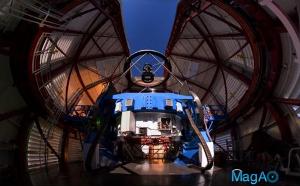Aug 22 2013
A team of astronomers from three institutions has developed a new type of telescope camera that makes higher resolution images than ever before, the culmination of 20 years of effort. The team has been developing this technology at telescope observatories in Arizona and now has deployed the latest version of these cameras in the high desert of Chile at the Magellan 6.5m (21 foot) telescope.
 The Magellan Telescope with MagAO’s Adaptive Secondary Mirror (ASM) mounted at the top looking down on the 6.5m (21 foot) diameter Primary Mirror. Photo by Moonlight, taken by Yuri Beletsky, LCO/Magellan Staff.
The Magellan Telescope with MagAO’s Adaptive Secondary Mirror (ASM) mounted at the top looking down on the 6.5m (21 foot) diameter Primary Mirror. Photo by Moonlight, taken by Yuri Beletsky, LCO/Magellan Staff.
Carnegie’s Alan Uomoto and Tyson Hare, joined by a team of researchers from the University of Arizona and Arcetri Observatory in Italy, will publish three papers containing the highest-resolution images ever taken, as well as observations that answer questions about planetary formation, in The Astrophysical Journal.
“It was very exciting to see this new camera make the night sky look sharper than has ever before been possible” said Laird Close of the University of Arizona, who was the project’s principal scientist. “We, for the first time, can make deep images that resolve objects just 0.02 arcseconds across—this is a very small angle—it is like resolving the width of a dime seen from 100 miles away, or like resolving a convoy of three school busses driving together on the surface of the Moon.”
This improvement results from the use of a large 6.5m telescope for photography at its theoretical resolution limit for wavelengths of visible light. Previously, large telescopes could make sharp photos only in infrared (long wavelength) light. Even large telescopes, those equipped with complex adaptive optics imaging cameras, could only make blurry images in visible light. The new camera can work in the visible spectrum and can make high-resolution photos, because as the resolution moves towards bluer wavelengths, the image sharpness improves.
To correct for atmospheric turbulence, the team developed a very powerful adaptive optics system that floats a thin (1.6 mm –1/16 of inch thick) curved glass mirror (85 cm across) on a magnetic field 9.2m above the big primary mirror of the telescope. This, so-called Adaptive Secondary Mirror (ASM) can change its shape at 585 points on its surface 1000 times a second. In this manner the “blurring” effects of the atmosphere can be removed, and thanks to the high density of actuators on this mirror, astronomers can see the visible sky more clearly than ever before.
“The Magellan community is delighted to have this powerful new capability, a final addition to our current instrument suite,” said Wendy Freedman, director of the Carnegie Observatories. “It also represents a significant technical milestone for the Giant Magellan Telescope.”
The new adaptive optics system, called MagAO, has already made some important scientific discoveries. As the system was being tested, the team tried to resolve the famous star that gives the Great Orion Nebulae most of its UV light. This 1 million-year-old star is called Theta 1 Ori C and it is about 44 times the mass of the Sun. It was already known to be a binary star (two stars rotating around each other); however, the separation between them is so small that this famous pair has never been resolved into two stars in a direct telescope photo. Once MagAO and VisAO (its visible-light camera) were pointed towards Theta Ori 1 C, the results were exciting and immediate.
The team also mapped out all the positions of the brightest nearby cluster stars and was able to detect very small motions as the stars slowly revolved around each other. Indeed a small group of five stars called Theta 1 Ori B was is likely a bound “mini-cluster” of stars, one that may eject the lowest mass star of the five in the near future.
The team also managed to address a longstanding question about how planets form. Scientists have long wondered whether the disks of gas and dust that surround a protoplanet are affected by the strong ionizing light and wind coming from a massive star, one like Theta 1 Ori C. The team used MagAO and VisAO to look for red light from ionized hydrogen gas to trace how the strong UV light and wind from Theta 1 Ori C affects the disks around its neighboring stars. MagAO’s photo shows that a pair of stars some 7 arcseconds away from Theta 1 Ori C was heavily distorted into “teardrop” shapes as the strong UV light and wind create shock fronts and drag gas downwind of the star, a very rare example of a low mass pair of young disks.
Another mystery about planetary formation is how the dust and gas are redistributed in a young disk. The team used VisAO’s special simultaneous/spectral differential imager (SDI) to image one of the rare “silhouette” disks in Orion. The disk is in front of the M42 nebula and so the astronomers could see the dark shadow cast as the dust in the disk absorbed the background light of the nebula. The SDI camera allowed the light from the star to be removed at a very high level, leaving, for the first time, a clear look at the silhouette, demonstrating that MagAO can make visible images of even very faint stars.